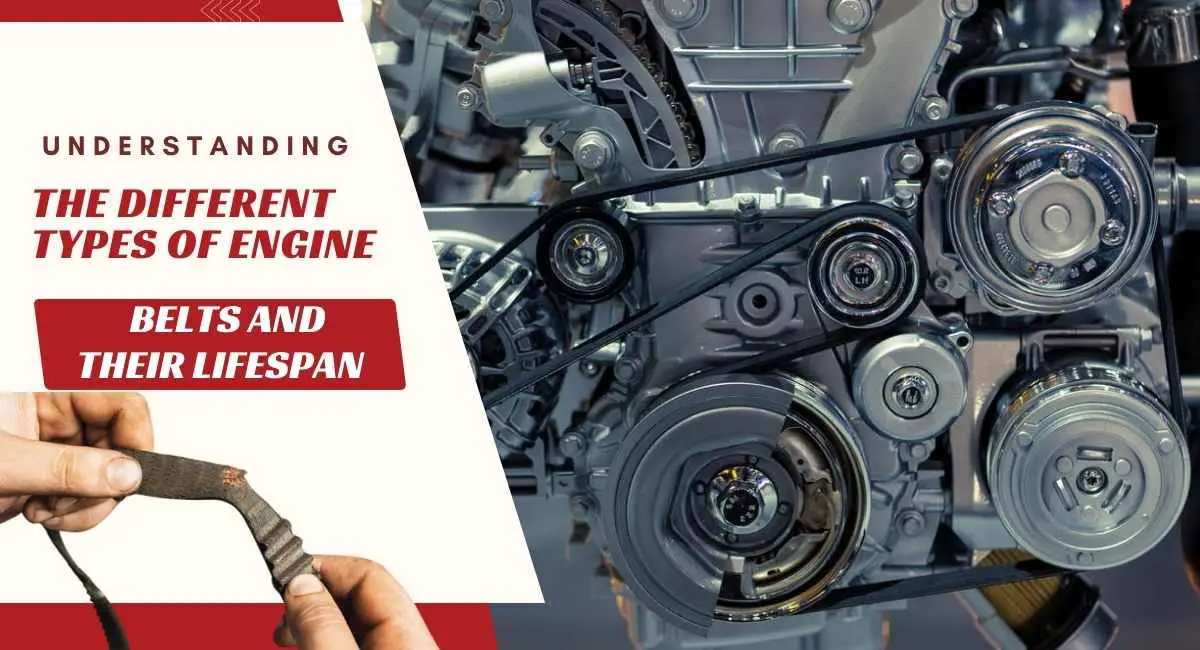As you drive, are you experiencing an alternator with inadequate charging, a belt drive system producing noise, or subpar performance of the air conditioning system? If this is your case, your car has an issue with the engine belt.
Engine belts come in three main types: serpentine, timing, and V-belts. Serpentine belts power various components concurrently, while timing belts ensure precise synchronization of internal engine movements. Historically significant V-belts are individual belts dedicated to specific components in modern engines.
So, what are these engine belts, what purposes do they serve, and how can we navigate their intricacies? Let’s answer these questions and understand the world of engine belts.
Types of Engine Belts
Engine belts are essential components that facilitate power transmission, synchronize engine movements, prevent damage, ensure efficient vehicle operation, and contribute to cost-effective maintenance practices.

There are three primary types of engine belts:
1. Serpentine Belts
A serpentine belt is a single, long belt that winds its way through various engine components, driving essential systems like the alternator, power steering pump, and air conditioning compressor. These belts are a craft made from durable materials such as neoprene. It is a marvel of engineering designed to endure the different movements within the engine.
The serpentine belt design is common in many vehicles, such as Ford, Chevy, and Dodge trucks. Yet, like any machine, a serpentine belt must be appreciated and maintained. Regular inspections to check for cracks, fraying, or glazing ensure its longevity.
Benefits of Serpentine Belts
Now, why should you settle for a serpentine belt?
- Serpentine belts efficiently transfer power to multiple engine components, ensuring coordinated and synchronous operation.
- The single-belt design of serpentine belts takes up less space in the engine compartment than multiple belts, contributing to a more compact and streamlined engine layout.
- With only one belt to monitor and maintain, serpentine belts simplify maintenance, making it easier for vehicle owners and mechanics to address potential issues.
Limitations of Serpentine Belts
- The failure of a serpentine belt results in the simultaneous loss of function for all connected components. It includes power steering, air conditioning, and charging, leading to a complete vehicle shutdown.
- If a serpentine belt snaps, the vehicle can immediately halt, leaving the driver without steering assistance and other critical functions.
- While this belt’s maintenance is simple in monitoring a single belt, replacing a serpentine belt can be more complex due to its integral role in powering numerous engine components.
How Long Can I Drive Down the Road Without a Serpentine Belt?
The safe operation window without a serpentine belt is relatively short, typically 15 to 30 seconds before noticeable issues arise. During this brief period, various complications can happen. So, you’re likely to experience the following:
- The absence of the serpentine belt leads to a loss of power steering assist, making steering considerably heavy and challenging to control.
- The alternator light will illuminate, signaling the disruption in the charging system and hinting at potential electrical issues.
- The air conditioning system, powered by the serpentine belt, will cease functioning, leading to a halt in cooling.
While some may attempt to continue driving, it becomes a strenuous and physical challenge. Persisting without the serpentine belt may lead to further complications.
- Continued operation without the serpentine belt may cause the engine to overheat, resulting in potential damage and compromised performance.
- The oil pressure light may illuminate, indicating insufficient lubrication for the engine. It poses a significant risk of engine damage.
Driving without a serpentine belt is not advisable beyond the initial seconds of awareness. The rapid onset of issues, ranging from loss of power steering to potential engine damage, emphasizes the importance of promptly addressing a broken or missing serpentine belt. Continued operation under such circumstances poses severe risks to the vehicle’s functionality and the engine’s integrity.
2. Timing Belts
A timing belt drives the engine’s camshaft, precisely synchronizing it with the crankshaft. This synchronization ensures the accurate timing of valve openings and closings, hence earning its name as a timing belt, as it precisely times the valvetrain.
So, this synchronization is vital for preventing collisions between pistons and valves, safeguarding the engine from potential damage. Typically made from materials like rubber with reinforced fibers, the timing belt is crucial.
The replacement interval for a timing belt ranges between 60,000 and 120,000 miles, contingent on manufacturer specifications. Certain manufacturers advocate replacement every 60,000 miles or every 5 years, while others may suggest a 120,000-mile interval or replacement every 10 years.
Besides, replacing a timing belt and the water pump is always wise. Why? The two components wear off at the same mileage; therefore, replacing only one means you’ll need to see a mechanic for the second fix.
Benefits of Timing Belts
- Timing belts offer precise timing of engine components, enhancing efficiency and performance.
- Their smooth operation minimizes friction, contributing to fuel efficiency and reduced wear on engine parts.
- Timing belts operate quietly, adding to the overall smoothness of the engine’s performance.
- As per manufacturer recommendations, regular replacement of timing belts is a cost-effective preventive measure to avoid more extensive engine damage.
Limitations of Timing Belts
Comprehending the drawbacks of timing belts empowers our clients to make well-informed decisions tailored to their specific applications. Limitations of timing belts encompass.
- Elevated cost
- Suitability for transferring power at relatively lower levels
- Transfer of power over relatively shorter distances compared to other drive belts.
3. V-Belts
V-belts are a nod to tradition in the automotive world’s evolutionary ballet. Historically significant, these belts have adapted and found their place in modern engines. Unlike the serpentine belt, V-belts are individual, each dedicated to a specific component like the alternator or water pump. Initially crafted from leather, modern V-belts boast synthetic materials for enhanced durability.
V belts play a pivotal role in turning multiple pulleys simultaneously within the engine system. For instance, a single V belt can concurrently drive various components like the alternator, air compressor, and power steering pump. This simultaneous operation is vital for these essential engine parts to function adequately.
Benefits of V Belts
- V belts efficiently transfer power to multiple engine components, ensuring a harmonious and coordinated operation.
- The V belt system is known for its space-efficient design, allowing it to operate multiple pulleys without requiring excessive engine space.
- V belt engines can accommodate multiple V belts, each dedicated to turning different engine parts, enhancing flexibility in design and functionality.
Limitations of V Belts
- The failure of a V belt can have cascading effects, impacting multiple engine components simultaneously. For instance, if the belt breaks, the alternator loses its ability to charge the battery, leading to a drained battery and potential vehicle stoppage.
- Replacing a broken V belt can be complex and requires professional expertise, especially in engines with multiple V belts.
- In engines with multiple V belts, the risk of simultaneous failures increases, affecting various functions like power steering assistance and alternator charging.
Factors Influencing Belt Lifespan
The lifespan of engine belts is influenced by several critical factors. Engine belts demand attention for each to play a pivotal role in determining these essential components’ overall durability and efficiency.
But you should know that, as of 2018, industry statistics show that timing belts were replaced in only 1.26% of cases. Over the past five years, replacement rates have decreased, primarily due to advancements in the belts’ quality.
Here are the key factors influencing the lifespan of engine belts:
Operating Conditions
The environment in which engine belts operate plays a crucial role in determining their lifespan. Extreme temperatures, whether exceptionally high or low, can compromise the structural integrity of the belts, hastening wear and tear.
Similarly, exposure to elevated humidity levels may contribute to the gradual deterioration of the belt materials. Furthermore, contaminants, such as oil, dirt, or debris, can expedite wear, emphasizing the importance of a clean operating environment.
Maintenance Practices
Regular and vigilant maintenance practices are paramount for prolonging the life of engine belts. Routine visual inspections serve as an effective means to detect early signs of wear, allowing for timely interventions before issues escalate.
Tension adjustments are equally critical, ensuring the belts maintain the optimal tension required for efficient performance. Adhering to manufacturer-recommended replacement schedules provides a structured approach to preemptive maintenance, reducing the risk of unexpected failures and enhancing overall belt longevity.
Quality of Belts
The choice of engine belts significantly influences their resilience and lifespan. The debate between Original Equipment Manufacturers (OEM) and aftermarket belts is a pivotal consideration.
While OEM belts are tailored to specific vehicle models and often of higher quality, high-grade aftermarket options can also offer durability. Material quality, such as the selection between rubber and synthetic compounds, further contributes to the overall robustness of the belts.
Additionally, belts manufactured with precision and adherence to stringent quality standards are more likely to endure the demanding engine operation conditions.
Signs of Belt Wear and Failure
Detecting signs of belt wear and potential failure is crucial for maintaining engine belts’ optimal performance and reliability.
Homer Hogg, the Director of Technical Service for TravelCenters of America, mentioned that contemporary belts, typically crafted from ethylene propylene diene monomer (EPDM), rarely exhibit visible signs of wear.
Hogg emphasized that visual inspections for cracks and splits could be more helpful. Instead, technicians should utilize a belt wear gauge tool as part of the process to accurately identify belts that require replacement.
Here are vital signs that may signify belt wear and potential failure:
Visual Inspection Indicators
A comprehensive visual inspection is an initial defense against potential belt wear and failure.
Cracks, visible along the surface of the belt and particularly at the edges, indicate wear, suggesting that the belt may be approaching the end of its effective lifespan.
Fraying, manifesting as worn or frayed edges, is a clear sign of deterioration, hinting at the impending risk of failure.
Additionally, a glazed or shiny appearance on the belt’s surface is a visual cue that excessive friction has occurred, raising concerns about wear and a potential decrease in efficacy.
Auditory Clues
Unusual sounds emitted from the engine bay during operation can provide valuable auditory clues to potential belt issues. Squeaking or chirping noises may indicate insufficient belt lubrication or wear, urging attention to the belt’s condition.
A high-pitched whining noise, especially during acceleration, might suggest belt slippage or tension-related problems. Similarly, slapping or flapping sounds could signify a loose or misaligned belt, potentially on the brink of failure.
The root cause must be identified and addressed if a belt is noisy. Applying chemicals to a belt can accumulate small pebbles and dirt, shortening the belt’s lifespan and potentially causing damage to other belt drive components like pulleys and tensioners.
To pinpoint whether the issue lies with the belt or a belt drive component, spray clean water on the belt. If the noise intensifies, it is likely a belt issue or belt slippage.
Conversely, if the noise dissipates, it may indicate a chirp resulting from a potentially misaligned pulley or tensioner.
Performance Issues
Observable vehicle performance changes can be critical indicators of underlying belt problems. Engine misfires, resulting from a disrupted timing of engine components, signal potential belt issues that require prompt attention.
You can attribute overheating to a malfunctioning belt affecting components like the water pump or radiator fan. Plus, a loss of power, often accompanied by reduced acceleration and overall diminished performance, may indicate slipping or damaged belts affecting power transmission.
Conclusion
Comprehending the diverse types of engine belts and their respective lifespans is fundamental to maintaining a vehicle’s optimal performance. Whether serpentine, timing, or V-belts, each plays a unique role in the intricate machinery of the automotive system. Timely recognition of wear signs and adherence to recommended replacement intervals ensure longevity and prevent unexpected failures. Ultimately, a well-informed approach to engine belt care contributes significantly to the overall reliability and efficiency of the vehicle.
